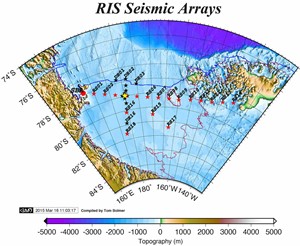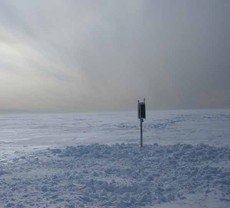Vibrations from waves shake Antarctic ice shelves
05 Oct 2015
A Scripps Institution of Oceanography, UC San Diego-led research team has found evidence that ocean wave energy generated thousands of miles away in the North Pacific Ocean vibrates ice shelves in Antarctica and may play a role in their disintegration.
 | |
| Map of a 34-station array of seismometers across Antarctica's Ross Ice Shelf. Scripps oceanographer Peter Bromirski and colleagues installed the network to study the vibrations from ocean waves that could cause the shelf to crack and eventually drift away from Antarctica. |
''The seismic survey studying the vibrations of the Ross Ice Shelf (RIS) in response to wave impacts will provide information on the structure and strength of the RIS, giving baseline state-of-health ice shelf measurements that will be used to identify the magnitude of changes in its integrity over time,'' said Bromirski, the project's principal investigator.
This study complements research by Scripps glaciologists published earlier in 2015 that revealed ice loss as much as 18 per cent in some Antarctic ice shelves over the past two decades. Combined with an upcoming analysis of atmospheric conditions over Antarctica, these studies will provide a comprehensive view of physical processes that could lead to substantial sea-level rise in all global oceans.
Ice shelves are slabs of ice that extend from land over the ocean like a cover on a jacuzzi. Though their disintegration does not directly cause sea level to rise, the buttressing effect they have on grounded ice sheets is removed and the flow of land ice into the ocean accelerates.
 | |
| A seismic station that is part of a 34-unit network across the Ross Ice Shelf. Scripps oceanographer Peter Bromirski and colleagues installed the network to study the vibrations from ocean waves that could cause the shelf to crack and eventually drift away from Antarctica. |
The Ross Ice Shelf is the largest ice shelf in Antarctica, measuring 487,000 square kilometers (188,000 square miles), an area roughly the size of Texas, and restrains West Antarctic grounded ice sheets that could contribute as much as three meters of sea-level rise.
The seismic data showed that impacts of infra-gravity (very long wavelength ocean waves) and ocean-swell induced vibrations in the ice that can be felt 100 kilometers (62 miles) away from the front of the Ross Ice Shelf. Much of the ocean wave energy originated in the North Pacific Ocean, and caused higher amplitude vibrations than waves generated locally in the Southern Ocean.
Bromirski said the dominance of the long-distance wave energy is still not understood. Nor do the preliminary data explain whether the signals recorded by the seismic stations were generated at the shelf front or closer to the stations. The array will continue gathering data for 24 months, giving observations of two full annual cycles of change and may capture signals influenced by the El Niño pattern that has developed in the Pacific Ocean.
Institutions participating in the study include Woods Hole Oceanographic Institution, Washington University in St. Louis, Colorado State University, and Penn State University.




















